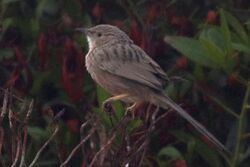Biology:Afghan babbler
| Afghan babbler | |
|---|---|

| |
| In Kuwait | |
| Scientific classification | |
| Domain: | Eukaryota |
| Kingdom: | Animalia |
| Phylum: | Chordata |
| Class: | Aves |
| Order: | Passeriformes |
| Family: | Leiothrichidae |
| Genus: | Argya |
| Species: | A. huttoni
|
| Binomial name | |
| Argya huttoni (Blyth, 1847)
| |
| Synonyms | |
| |
The Afghan babbler (Argya huttoni) is a species of bird in the family Leiothrichidae. It is found from southeastern Iraq to south western Pakistan. It was formerly considered a subspecies of the common babbler.
When compared to the common babbler, the Afghan babbler has a heavier bill and dark streaks on the breast and sides. The vocalizations are also different.[1][2] The variation is sometimes considered to be clinal but two subspecies have been recognized.[3][4][5] The Afghan babbler group includes salvadorii (De Filippi, 1865) found in Iraq and western Iran and huttoni (Blyth, 1847) from eastern Iran through Afghanistan east to southwestern Pakistan.
The Afghan babbler was formerly placed in the genus Turdoides but following the publication of a comprehensive molecular phylogenetic study in 2018, it was moved to the resurrected genus Argya.[6][7]
References
- ↑ Rasmussen, P.C.. "Biogeographic and conservation implications of revised species limits and distributions of South Asian birds.". Zool. Med. Leiden 79 (13): 137–146. http://www.repository.naturalis.nl/document/42176.
- ↑ Collar, NJ (2006). "A partial revision of the Asian babblers (Timaliidae)". Forktail 22: 85–112. Archived from the original on 2012-02-15. https://web.archive.org/web/20120215213207/http://www.orientalbirdclub.org/publications/forktail/22pdfs/Collar-Babbler.pdf.
- ↑ Deignan, H; RA Paynter Jr.; S D Ripley (1964). Mayr, E. ed. Check-list of Birds of the World. Volume 10. Museum of Comparative Zoology. pp. 332–333. https://www.biodiversitylibrary.org/page/14486521.
- ↑ Abdulali, Humayun; D'Cunha, Eric (1982). "On the validity of Turdoides caudatus eclipes (Hume).". J. Bombay Nat. Hist. Soc. 79 (1): 199–200.
- ↑ Vaurie, C (1953). "Systematic notes on Palearctic birds no. 3. Turdoides caudatus and Turdoides altirostris.". Am. Mus. Novit. 1642: 1–8.
- ↑ Cibois, A.; Gelang, M.; Alström, P.; Pasquet, E.; Fjeldså, J.; Ericson, P.G.P.; Olsson, U. (2018). "Comprehensive phylogeny of the laughingthrushes and allies (Aves, Leiothrichidae) and a proposal for a revised taxonomy". Zoologica Scripta 47 (4): 428–440. doi:10.1111/zsc.12296.
- ↑ Gill, Frank; Donsker, David, eds (2019). "Laughingthrushes and allies". World Bird List Version 9.1. International Ornithologists' Union. http://www.worldbirdnames.org/bow/laughingthrushes/. Retrieved 20 January 2019.
- Collar, N. J. & Robson, C. 2007. Family Timaliidae (Babblers) pp. 70 – 291 in; del Hoyo, J., Elliott, A. & Christie, D.A. eds. Handbook of the Birds of the World, Vol. 12. Picathartes to Tits and Chickadees. Lynx Edicions, Barcelona.
Wikidata ☰ Q47489639 entry
 |

